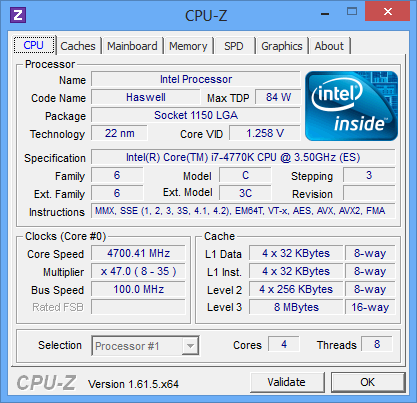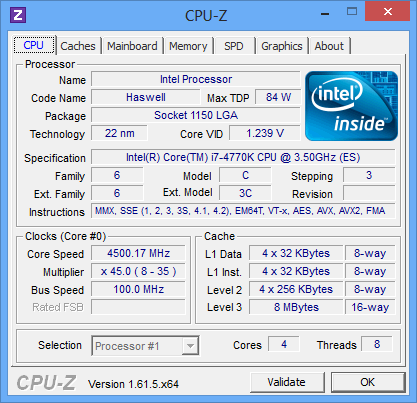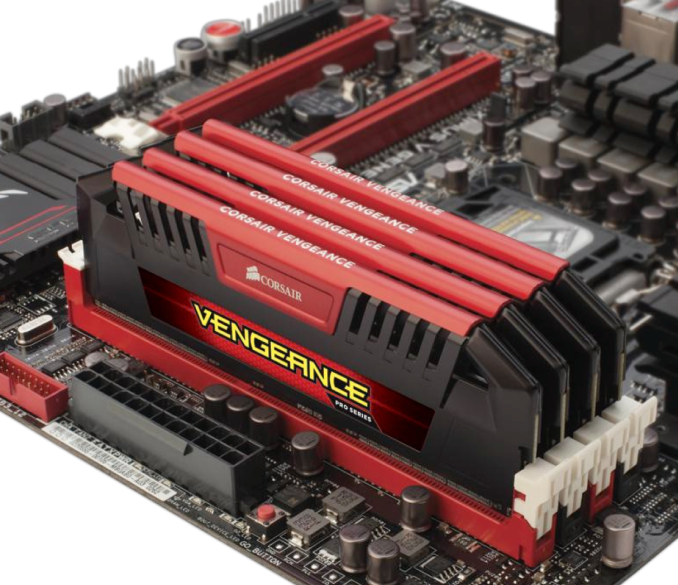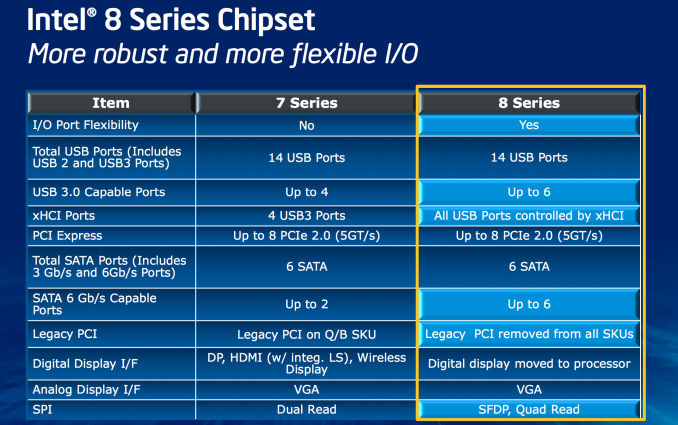The Haswell Review: Intel Core i7-4770K & i5-4670K Tested
by Anand Lal Shimpi on June 1, 2013 10:00 AM ESTMemory
Haswell got an updated memory controller that’s supposed to do a great job of running at very high frequencies. Corsair was kind enough to send over some of its Vengeance Pro memory with factory DDR3-2400 XMP profiles. I have to say, the experience was quite possibly the simplest memory overclocking I’ve ever encountered. Ivy Bridge was pretty decent at higher speeds, but Haswell is a different beast entirely.
Although I used DDR3-2400 for most of my testing, Corsair’s Vengeance Pro line is available in frequencies rated all the way up to 2933MHz.
Platform
Haswell features a new socket (LGA-1150). Fundamental changes to power delivery made it impossible to maintain backwards compatibility with existing LGA-1155 sockets. Alongside the new socket comes Intel’s new 8-series chipsets.
At a high level the 8-series chipsets bring support for up to six SATA 6Gbps and USB 3.0. It’s taken Intel far too long to move beyond two 6Gbps SATA ports, so this is a welcome change. With 8-series Intel also finally got rid of legacy PCI support.
Overclocking
Despite most of the voltage regulation being moved on-package, motherboards still expose all of the same voltage controls that you’re used to from previous platforms. Haswell’s FIVR does increase the thermal footprint of the chip itself, which is why TDPs went up from 77W to 84W at the high-end for LGA-1150 SKUs. Combine higher temperatures under the heatspreader with a more mobile focused chip design, and overclocking is going to depend on yield and luck of the draw more than it has in the past.
Haswell doesn’t change the overclocking limits put in place with Sandy Bridge. All CPUs are frequency locked, however K-series parts ship fully unlocked. A new addition is the ability to adjust BCLK to one of three pre-defined straps (100/125/167MHz). The BCLK adjustment gives you a little more flexibility when overclocking, but you still need a K-SKU to take advantage of the options.


In terms of overclocking success on standard air cooling you should expect anywhere from 4.3GHz - 4.7GHz at somewhere in the 1.2 - 1.35V range. At the higher end of that spectrum you need to be sure to invest in a good cooler as you’re more likely to bump into thermal limits if you’re running on stable settings.

















210 Comments
View All Comments
JDG1980 - Saturday, June 1, 2013 - link
Those tests you linked are purely synthetic benchmarks. Has anyone found a significant real-world application where Haswell is slower than SB/IB at the same clock speed?krumme - Saturday, June 1, 2013 - link
Has anyone found a significal real-world application where Haswell matter?smilingcrow - Saturday, June 1, 2013 - link
Has anyone found a significant real-world comment from you that matters?rupert3k - Saturday, June 1, 2013 - link
*high fives*Aditya211935 - Sunday, June 2, 2013 - link
http://www.techoftomorrow.com/2013/pc/intel-haswel...This One is pretty nice.
Altough the list of games given there is a bit shallow but still it gives you a general idea.
jeffkibuule - Saturday, June 1, 2013 - link
Haswell isn't just about the CPU, it's about the entire platform of chips, even the tiny ones on the motherboard no one really cares about. And I'm not sure what you were expecting in terms of performance gains, as there isn't any competition in the desktop arena for it to be worth pushing out 20-25% gains (and certainly not on a yearly basis).As far as active power goes, the entire point of a modern CPU architecture is to "hurry up and go to sleep (HUGS)". Faster you go to idle and the better idle performance you have, the better battery life you get because lets face it, unless you're encoding a video or playing a game, your CPU spends most of its idling doing nothing.
B3an - Saturday, June 1, 2013 - link
You're right. If anyone is to be blamed for the slight performance increase of Haswell, it's AMD. If AMD could actually compete on performance we would be seeing more gains with Haswell, and maybe FINALLY more than 4 cores on mainstream Intel platforms.DeadlyRicochet - Tuesday, June 4, 2013 - link
And I wonder how successful AMD would have been if Intel never stole their revenue (when AMD chips were faster than Intel, around 2006) by making under the table deals with OEMs to use Intel only CPUs.deepblue08 - Saturday, June 1, 2013 - link
I disagree somewhat. Especially with the fact that you think idle power consumption is unimportant. Keep in mind, that at least half of the time, when you are working, browsing the net, your cpu is in fact idle. So an improvement in idle performance consumption is a big deal imo.Hector2 - Saturday, June 1, 2013 - link
You've got it all wrong. Haswell won't be going up against ARM in tablets. Don't look for it in smartphones either ! LOL A Haswell i7 is serious overkill for those markets. ARM won't be getting into the serious laptop & PC market soon either --- they just can't compete well with Intel there. Intel is targeting their smaller & less power-hungry Atoms for the phone & tablet markets (surely you know this ?) that are driven by low power requirements. The press just leaked that Samsung's new Galaxy Tab 3 will have dual core Clover Trail+ Atoms